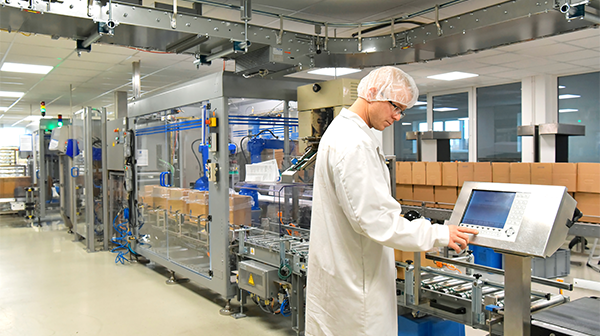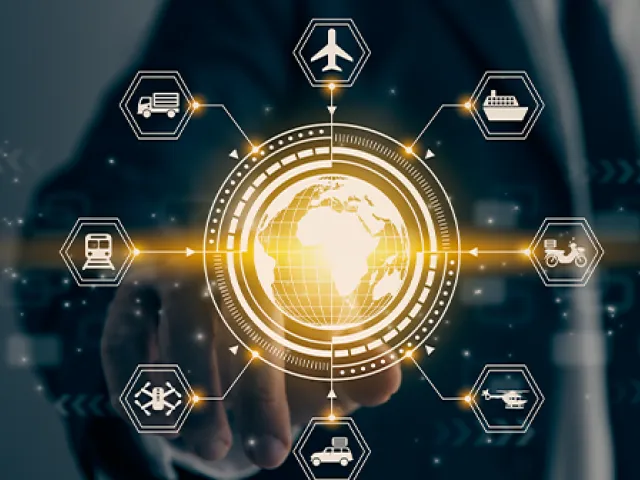Table of contents

TraceLink CEO Shabbir Dahod joins industry leaders at FutureLink Barcelona for an in-depth discussion on the challenges and benefits of supply chain digitalization. This uniquely qualified panel explores the technical, operational, and organizational challenges of supply chain digitalization and offers guidance on how to align cross-functional and cross-company leaders to move transformational supply chain projects forward.
Learn how network-based supply chain orchestration based on real-time data exchange ensures supply chain resiliency and risk reduction while accelerating other IT projects, including ERP upgrades. Watch now!
Featured Speakers:
Shabbir Dahod
President and CEO
TraceLink
Stephanie Hart
Executive Vice President, Head of Operations
Nestlé
George Llado
Board Member Charles River Laboratories, Sierra Ventures, and TraceLink
Former CIO Alexion & Merck
Alessandro de Luca
Group CIO and Head of IT
Merck Group
Marco Odoardi
Global Head of Integrated Operations Planning
Merck
TRANSCRIPT
TRANSCRIPT
Shabbir Dahod: I think it gives you a glimpse of the people we try to surround ourselves with. I've known George for 15 years.
George Llado: Many years.
Shabbir: Customer number one on what was the precursor to MINT, father of MINT. [laughs] George was very involved in the early days of us forming some of the thoughts around it and so forth. With Alessandro, I think we had a breakfast before a panel discussion that we had, or fireside chat.
When I first proposed to him about five years ago, and said, "Hey, want to head down this path?" and what you thought. He's been a source of inspiration for me and keeping us motivated to moving this forward.
Stephanie joined the board about two years ago, I believe.
Stephanie Hart: Yeah.
Shabbir: We went deliberately out to say, "Hey, we really want somebody on the board that has vast supply chain experience because we as a board need to hear that because we've got the CIO with George. We need a strong supply chain leader."
Her background is actually Nestlé, then Beyond Meat, and then Wary Parker. She's seen lots of different types of business. Then back to Nestle because Nestlé wouldn't let go of her that easily. Effectively, she is the CEO of Nestlé.
These are people that I trust completely and people that I seek advice from. Marco is a new addition, an inspiration to us as well as we now move forward to the predictive supply chains and prescriptive ones.
The first question I'd like to ask, because these are types of conversations we have all the time, is from your perspective, Stephanie. You have worked in so many different businesses. When you think about originally in Nestlé, then Beyond Meat, then Wary Parker.
You've seen the challenges at different stages and scales of businesses and the value of information. As a supply chain leader how would you quantify the value of information in the ability to execute on a day-to-day basis, forecast forward, and so forth?
Stephanie: Thank you for the question. When I look at the value of data, it's almost limitless. I was participating in a different forum and I said accurate data is the new currency. The ability to have accurate data, as it was so eloquently pointed out by my colleagues on stage, is critical and essential.
It'll determine whether organizations are going to be efficient, effective, and really agile, future-forward, or if they're going to get left behind and sucked up by something else. The ability to embrace that data, to understand it, to understand how to see into the future and be able to better predict is going to be just the expectation and the new norm.
Whether you're in a startup or a well-established organization, it becomes even richer. We're fortunate enough in Nestle to have had 20 years to implement SAP. We've got a lot of data, but we've got to figure out, how do we connect it all together?
Shabbir: In one of our round table discussions that we had as an executive council, one of the discussions that went on is trying to apply AI without good data gives you a lot of hallucinations.
[laughter]
Shabbir: From your perspective, Alessandro, how do you manage that? AI obviously has tremendous potential, but it may also have some limitations.
How do you manage the potential impact that AI has, both from the perspective of managing how to use it, and then also managing the change that has to happen within an organization to leverage AI?
Like I said earlier, right now, as an example, we have now launched Amadeus. A big question is how do you do certifications if you can just go ask the question? You can just get the answers right away, so exams could be passed like that.
Alessandro de Luca: That's a fascinating question because I receive it every day. You can imagine the board keeps asking, "Oh, when we implement more AI, we can buy a company doing AI." Imagine Merck buying a company doing AI and whatever, and so on and so forth.
Then you know I'm in IT. IT, every single day, you receive mail from every employee in the world saying, "Hey. Can you give me Copilot? Can you give ChatGPT? What about this?" and so on and so forth.
That's why, Mike, I have two crusades. One crusade that I was very happy, Stephanie said it, and Shabbir too, about the data. AI without data, I'm not going to repeat it, obviously, it's useless.
The other crusade is about the people, really about the people. The technology works if you have the data and if you use it. [laughs] Assuming we have the technology, assuming that we have the data, then we should be able to use it. That means that we should be able to involve the user to understand how to exploit it.
I always say I have this Oura rings. I don't know if you ever seen Oura rings. Oura rings collects data from your body when you sleep and so on and so forth. Then if I do nothing with those data, [laughs] [laughs] absolutely useless. Technology plus data, you need people to do it.
That's why together with the head of HR, we launched a program that is called Humanizing, where the AI is bigger.
Shabbir: That's clever.
Alessandro: That means it's a partnership between human and AI exactly to upscale and reskill our 63,000 employee about leveraging AI data and technology. That's why we wanted to on purpose cosponsor from the CIO and the chief HR officer because it's really human and technology together makes a difference.
Shabbir: I think that's one of the biggest concerns people have, is that they're fearful of it. They sometimes overestimate it, but in general, people are fearful. In reality, I'm old enough to remember when we went from typesetting to Word and all that. People go, "Oh my god, there will be no more typesetters," but in reality, everyone became a typesetter.
[laughs]
Alessandro: Exactly.
Shabbir: It's about how you leverage it and making people feel comfortable with it. Bridging to the next topic there for Marco. In integrated operations planning, obviously, you have to bring a lot of people together to get them on the same page and work cross-functionally.
One of my biggest challenges I see even for us to navigate an organization is that as we navigate the organization, even from the logistics, let alone sales and marketing, but logistics to still manufacturing to procurement and direct supply, they oftentimes work in silos.
How do you get people to actually work together and to work cross-functionally and leverage the power of the tools and the predictions together?
Marco Odoardi: This is the most fascinating part of my job because I'm calling this the democratization of the supply chain data. The most important part is allowing people to understand that actually, data and scenario are not owned anymore by one single part of the organization.
Everyone has access to the full picture of what is happening across the world, across department, across division, across forecasts, across whatever, but this doesn't mean that everyone having access and transparency on what is happening can take uncoordinated decisions and starting to generate a chaotic system.
This is bringing us to a new era, the era of the real collective intelligence using multiple brains across different function, across different geographies on the same set of data scenario, and so on.
The interesting part is using different human intelligence on the same set of scenario data can lead to different interpretation. This is the risk, but at the same time, it's also the fascinating part of it, is where you add value.
Imagine a world in which the head of one department doesn't take decisions only based on understanding the picture and the shadow for his own department, but understand also the mutual intercorrelation with other department. It's a totally different way of leading a company.
This means that we need to have really strong change management and program to lead the organization to work in a different way, even entering into discussion of process, role and responsibility, behaviors, human behaviors, etc.
However, I'm a strong believer that this collective intelligence bring much better business result.
Shabbir: To extend that question, you also have the fact that you want to collaborate freely with your partners.
So that as we now move forward, as Alessandro evidenced in the fast-moving consumer goods, is the collaboration between the partners, whether it's with a Walmart or a Target, along with your suppliers, and providing that ability to see end-to-end and collaborating together to make sure that we're all orchestrating together.
It's another level of challenge as well that we all have to go through as well.
Alessandro: Indeed.
Shabbir: Thank you for that answer. George, I know that as a CIO, I love your comment. George made a great comment at our sales kickoff. He says CIO can either be the cheap information officer or the chief innovation officer.
[laughs]
We oftentimes see that challenge in organizations. It just happens to be the phase, as you noted, that companies go through, and the competing priorities. The business issues and the competing priorities.
However, right now, the industry is very much occupied with a different deadline, which is SAP HANA. There are trade-offs that they have to make, and prioritization, and so forth. I know that HANA being a new ERP, it may not necessarily give you vastly more capabilities.
From a CIO perspective, how do you balance investing in basically upgrades versus investing in innovations with the budgets you have, and how do you partner with your business counterparts and supply chain to achieve that balance?
George: First, it's not easy, but let me step back. I may take up the rest of the time for the session, so I just want to give you a heads up. A couple of things. One, I'm severely underdressed.
[laughter]
George: Purposefully so. One, I don't have a job.
[laughter]
George: I've retired and decided not to actually go back to work, so I'm doing other cool stuff like investing, board work, and things like that, but what that means is I can say anything I want. The people that I used to work for, I was under NDA. I couldn't say bad stuff about them. I can say bad stuff about everybody, including TraceLink, by the way.
[laughter]
[applause]
George: You can ask me any question after this or whatever. I have no ties. No lawyers will come after me. I'll get no emails that'll tell me I shouldn't have said it. I can say whatever I want. That's the first thing.
Second thing, I've never seen Shabbir more excited. I've been honored to know him for 15 years. Now being part of his board, his first memo, the first sentence that he sent to the board several weeks ago when we met, was, "We have an awesome product."
When he started the meeting, he started the meeting with, "We have an awesome product," and he described why and brought in people like Bob and other folks to talk about the product. It's an amazing product. I've never seen you more excited, by the way.
Now let me go on to your question...
[laughter]
George: given that caveat and transparency. In terms of SAP or ERP and competing priorities, I've always had a pretty clear process on how I prioritize. I've done it from 13 years ago, literally up to 2022 when I retired. I'll talk a little bit more about this on Friday. There's a session tomorrow morning where I'm talking about this.
It's rooted in the fact that there is a company-wide objective. The company says something. We either have a product that we're launching that's really big this year. We need to put our shoulder behind commercial, maybe not research this year, but commercial and manufacturing, versus we're discovering and we need products and pipelines.
We need to put our shoulders behind research and perhaps not as much commercial and manufacturing. That's the North Star for the entire company.
What I would do is I would take that North Star, and each business, whether you're research, whether you're go-to market commercial, whether you're manufacturing or you're HR legal, you have strategies and objectives for that year to meet that North Star.
What I would put together is a sheet. It was 11 by 17, not digital at the time, but 11 by 17, that would eventually map every single business capability that the company had. I had a business capability map.
If this year, you had a capability called clinical trial enrollment, which is where you have a drug, and you've pushed it through an animal, and it's efficacious and safe, and now you need to test it in humans, you have to enroll humans.
For any particular year, that would be really, really important if you're in phase 1 of developing a product. When I look at technology, whether it's ERP, or it's limbs, or it's shop floor, I look at what are the objectives of the company? If I need to focus on clinical trial enrollment, guess what, I'm not focusing on ERP that year.
I figure out, given where the company is going three to five years, where I would need to invest in an S/4HANA, versus my pharmacovigilance or my clinical trial enrollment, monitoring system, etc. Those are my unemotional walking papers that take me through the organization every single year.
I would stop things and start based on what the conditions were of the company. As you mentioned, Shabbir, there are down cycles and up cycles. You've got to be cheap some years and you have to cut because the company has issues in pipeline or commercial product, or we are growing tremendously and here's where we're going to invest. You have to pivot based on that.
Shabbir: Excellent. I know you may have questions, so I want to open it up to the floor. Anyone have any questions, please?
Man: Shabbir, I'm at the back with a microphone. Do I see a hand right at the front?
Shabbir: Yes, there is.
Man: We are on our way. Thank you. These are my steps for the day.
[laughter]
Federico Casaglia: Thank you. Federico Casaglia from CIT, Italy. A question to Marco, if it's possible. First of all, let me thank you all the speakers for the interesting talks and insights. Regarding the minority report dashboard...
[laughter]
Federico: for the future. It has been very interesting. You have shown the different KPIs, cost, service levels, quality, inventory, and so on. You have seen in your example, in 18 months, we will find an issue on the service level. I can act in advance trying to configure it the different parameter and finding the [inaudible] solution.
A single process that are visible to anyone, but at the very end, under a decision-making perspective, responsibility are not so shared for a single person, and those KPIs are in trade-off many of the times. Leveraging on the service level could implies maybe to worsen the quality.
Man: Your question?
Audience Member: At the very end, how can you imagine all these trade-off in this future picture?
Man: Thank you.
Marco: This is extremely interesting question because actually, all this vision is based on the idea that the business is based on trade-off. The most difficult part of the top executive today is taking trade-off. Now, the idea is the moment in which the trade-off are transparent, most probably, many person will converge on similar interpretation.
If this is true, common sense. When this is not true, obviously, we need to be extremely clear on one responsibility, almost a RACI matrix. As a last step, eventually escalate up. However, we really need to trust on the good judgment of our leaders, themoment in which it is really transparent.
There is one scenario, and everyone has the same scenario, it's extremely difficult to diverge because we are all working for the good of the humanity, of the company, of the society.
Man: Our next question is right here. Go ahead.
Audience Member: Hello. This question is for Stephanie. What are the biggest hurdles you face when adopting a new technology for operational efficiencies in supply chain processes? That's my question.
Stephanie: The biggest hurdle? [laughs] Being a very matrixed organization, what it used to be, I should say, and where it's going to or what we are now is it was this market has found a solution, even though we had a global solution, and they think it's going to work a little bit better.
This market's like, "Well, we've piloted that, and it doesn't really work exactly the way we need to, so we're going to tweak it a little bit more." Then this market says the same thing. You end up having a whole bunch of experts, and the solutions are probably fairly decent.
What we've come to now is there are some areas, particularly when we've actually rolled out some of our digital solutions, where it's total performance management plus four digital tools. We're no longer allowing people to pick the digital tools that we've mandated.
Now we've actually said, "These are the four digital tools that everyone will have," but we actually are going back to the focus, so the whole trade-off discussion. The focus is on what are the top 100 SKUs that are contributing to 80 percent of the turnover? Then those are the ones that we're addressing with those four mandated solutions.
In a large matrix organization, it's difficult because you're trying to ensure that the 270,000 employees, which everyone has the best of intentions to do what's right for the organization, it may actually go against what we're trying to do as a collective organization as we link all the technologies together.
Man: Next question is at the very back of the room. We have Carlos.
Carlos: Hi. For Stephanie. Carlos [inaudible] . I work for Nestlé. I'm being involved in all these supply chain project, like at the hubs, oceans, and traceability in GSG. The question for you is how do you vision the data collection from suppliers in the future? You can see all the data that basically we are going to consume in Nestlé are coming from our suppliers.
Stephanie: Great question because we're having some different strategic discussions right now with maybe some people in this room, where we can actually better link. It's been difficult and good.
As I said, it took us 20 years, roughly, to implement SAP. It was a massive project for us. It has actually allowed us to be able to have really, really strong visibility within our organization.
That being said, we still have the need, when we're actually working with other businesses and suppliers, to have to come up with different work solutions that can talk to SAP or give all these guidelines.
Which is why we're exploring what solutions, like what's being offered in MINT, which wasn't specifically designed for our industry, and more specific to pharma, but what solutions like that could actually add, and how it can unlock even more power for us as an organization.
I have really high aspirations of what can happen, but we do need to make sure that we have a more simplified process to, A, have that connectivity, which will then allow us to have the visibility.
Shabbir: Just so you know, Nestlé is a customer.
Stephanie: Yes. We are. [laughs]
Shabbir: Nestlé Health Sciences does distribute prescription products as well. Thank you for the question.
Man: Shabbir, with just a few minutes left, may I ask a question to anyone on the panel, which is with this end-to-end opportunity, what's the low-hanging fruit? Everyone is at a different point on the journey. What is something they should be doing as soon as they get back to the office? Alessandro?
Alessandro: Fix the basics. Without the basics, you don't go to AI.
Man: Anyone like to add? George.
George: This company, TraceLink, has your data. They got a ton of data. Ask for it. Work with them. This Amadeus thing you'll probably hear about in the next couple of days, you can layer that on top of your data and do amazing things. Artificial intelligence. If you don't have the intelligence, it's artificial. They've got the intelligence, and they can help. Ask for it.
Stephanie: Focus on the people and change management. It's something that is completely underestimated because this is a massive change in the way that the thinking occurs and the way that you operate. Don't forget about people who are your greatest asset, and ensure you have really, really strong change management.
Man: I love how some of your people are in the room. Even better. Shabbir, last thoughts?
Shabbir: The main thing for me, what I find is that it's about the relationships between yourself and your partners. I think that especially in the pharma industry, that has been one that has not been digital and not necessarily always been collaborative, like you see in other industries.
Having every part of the supply chain be willing to share information, do the digital integrations, and to be more open to that next model. Because otherwise, we will all just stay in the very underperforming capabilities that we have on an end-to-end basis.
It's very important to focus on, whether it's your contract manufacturer or the direct supplier to you, make sure you're looking for the win to win and not just look at it as a financial transaction between the two of you.
[background music]
Shabbir: I think it's very important to do that.






